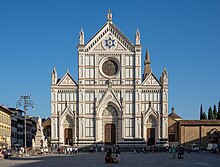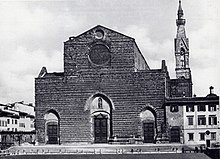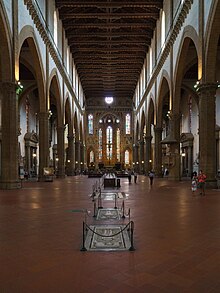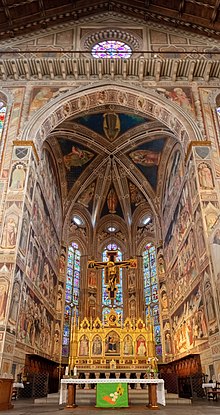
Andrea del Castagno or Andrea di Bartolo di Bargilla was an Italian Renaissance painter in Florence, influenced chiefly by Masaccio and Giotto di Bondone. His works include frescoes in Sant'Apollonia in Florence and the painted equestrian monument of Niccolò da Tolentino (1456) in Florence Cathedral. He in turn influenced the Ferrarese school of Cosmè Tura, Francesco del Cossa and Ercole de' Roberti.

Santa Maria Novella is a church in Florence, Italy, situated opposite, and lending its name to, the city's main railway station. Chronologically, it is the first great basilica in Florence, and is the city's principal Dominican church.

Desiderio da Settignano, real name Desiderio de Bartolomeo di Francesco detto Ferro was an Italian Renaissance sculptor active in north Italy.

Taddeo Gaddi was a medieval Italian painter and architect.

Agnolo Gaddi (c.1350–1396) was an Italian painter. He was born and died in Florence, and was the son of the painter Taddeo Gaddi, who was himself the major pupil of the Florentine master Giotto.

Antonio Gamberelli (1427–1479), nicknamed Antonio Rossellino for the colour of his hair, was an Italian Renaissance sculptor. His older brother, from whom he received his formal training, was the sculptor and architect Bernardo Rossellino.

Bernardo di Matteo del Borra Gamberelli (1409–1464), better known as Bernardo Rossellino, was an Italian Renaissance sculptor and architect, the elder brother of the sculptor Antonio Rossellino. As a member of the second generation of Renaissance artists, he helped to further define and popularize the revolution in artistic approach that characterized the new age. His work is often hard to distinguish from that of his brothers working in the family workshop.

Santa Felicita is a Roman Catholic church in Florence, region of Tuscany, Italy, probably the oldest in the city after San Lorenzo. In the 2nd century, Syrian Greek merchants settled in the area south of the Arno and are thought to have brought Christianity to the region. The first church on the site was probably built in the late 4th century or early 5th century and was dedicated to Saint Felicity of Rome. A new church was built in the 11th century and the current church largely dates from 1736–1739, under design by Ferdinando Ruggieri, who turned it into a one nave edifice. The monastery was suppressed under the Napoleonic occupation of 1808–1810.

The Badìa Fiorentina is an abbey and church now home to the Monastic Communities of Jerusalem situated on the Via del Proconsolo in the centre of Florence, Italy. Dante supposedly grew up across the street in what is now called the 'Casa di Dante', rebuilt in 1910 as a museum to Dante. He would have heard the monks singing the Mass and the Offices here in Latin Gregorian chant, as he famously recounts in his Commedia: "Florence, within her ancient walls embraced, Whence nones and terce still ring to all the town, Abode aforetime, peaceful, temperate, chaste." In 1373, Boccaccio delivered his famous lectures on Dante's Divine Comedy in the subsidiary chapel of Santo Stefano, just next to the north entrance of the Badia's church.

San Miniato al Monte is a basilica in Florence, central Italy, standing atop one of the highest points in the city. It has been described as one of the finest Romanesque structures in Tuscany and one of the most scenic churches in Italy. There is an adjoining Olivetan monastery, seen to the right of the basilica when ascending the stairs.

The Peruzzi family were bankers of Florence, among the leading families of the city in the 14th century, before the rise to prominence of the Medici. Their modest antecedents stretched back to the mid 11th century, according to the family's genealogist Luigi Passerini, but a restructuring of the Peruzzi company in 1300, with an infusion of outside capital, marked the start of a quarter-century of prosperity that brought the family consortium to the forefront of Florentine affairs.

San Marco is a religious complex in Florence, Italy. It comprises a church and a convent. The convent, which is now the Museo Nazionale di San Marco, has three claims to fame. During the 15th century it was home to two famous Dominicans, the painter Fra Angelico and the preacher Girolamo Savonarola. Furthermore, the church houses the tomb of Pico Della Mirandola, a Renaissance philosopher and the so called "Father of Humanism."

Florentine painting or the Florentine School refers to artists in, from, or influenced by the naturalistic style developed in Florence in the 14th century, largely through the efforts of Giotto di Bondone, and in the 15th century the leading school of Western painting. Some of the best known painters of the earlier Florentine School are Fra Angelico, Botticelli, Filippo Lippi, the Ghirlandaio family, Masolino, and Masaccio.

Maso di Banco was an Italian painter of the 14th century, who worked in Florence, Italy. He and Taddeo Gaddi were the most prominent Florentine pupils of Giotto di Bondone, exploring the three-dimensional dramatic realism inaugurated by Giotto.

Niccolò di Pietro Gerini was an Italian painter of the late Gothic period, active mainly in his native Florence although he also carried out commissions in Pisa and Prato. He was not an innovative painter but relied on traditional compositions in which he placed his figures in a stiff and dramatic movement.

San Francesco de' Ferri is a church in Pisa, Tuscany, Italy.

The Basilica dell'Osservanza is a church on the outskirts of Siena, region of Tuscany, Italy.
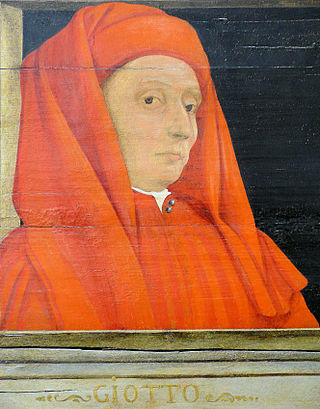
Giotto di Bondone, known mononymously as Giotto and Latinised as Giottus, was an Italian painter and architect from Florence during the Late Middle Ages. He worked during the Gothic and Proto-Renaissance period. Giotto's contemporary, the banker and chronicler Giovanni Villani, wrote that Giotto was "the most sovereign master of painting in his time, who drew all his figures and their postures according to nature" and of his publicly recognized "talent and excellence". Giorgio Vasari described Giotto as making a decisive break from the prevalent Byzantine style and as initiating "the great art of painting as we know it today, introducing the technique of drawing accurately from life, which had been neglected for more than two hundred years".

The Bartolini Salimbeni Chapel is a chapel in the church of Santa Trinita, Florence, central Italy. Its decoration by Lorenzo Monaco, dating to the 1420s, are one of the few surviving examples of International Gothic frescoes in Italy. The chapel has kept other original elements, such as its altarpiece, an Annunciation, also by Monaco, and the railings.
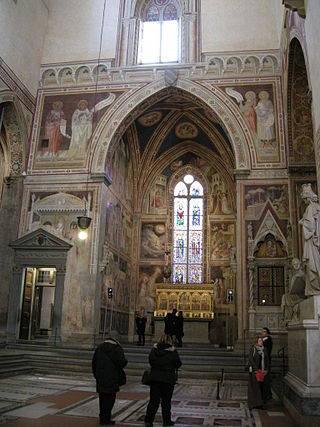
The Baroncelli Chapel is a chapel located at the end of the right transept in church of Santa Croce, central Florence, Italy.
